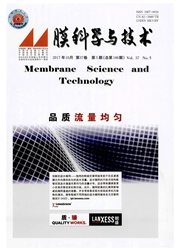

 中文摘要:
中文摘要:
采用表面粗糙度仪、扫描电子显微镜(SEM)和三维非接触表面形貌仪(WLI)表征膜表面形貌,并考察了陶瓷膜表面粗糙度对过滤含油废水性能的影响.结果显示,具有不同表面粗糙度的相同孔径陶瓷膜,其纯水通量基本相同;粗糙度越大的膜,过滤含油废水的膜通量衰减越快,稳定通量也越低;陶瓷膜表面粗糙度对油截留率基本没有影响;废水中油滴粒径的变化对粗糙度大的膜的稳定通量影响显著,表明光滑膜更适合于处理含油废水.
 英文摘要:
英文摘要:
The information of surface morphology was provided by surface roughness tester, scanning electron microscopy (SEM) and white light interferometer (WLI), and the effect of surface roughness of ceramic membrane on the performance of filtrating oily wastewater was investigated. The ceramic membranes with the same pore size and different surface roughness had the same pure water flux. The results of filtrating oily wastewater indicated that the rougher membranes had larger flux decline and lower steady flux than that of smoother ones. With the change of droplet size in the wastewater, the rougher membrane had the larger change of the steady flux. Surface roughness had little effect on oil rejection. This study indicated that smoother membrane was suitable for treating oily wastewater.
 同期刊论文项目
同期刊论文项目
 同项目期刊论文
同项目期刊论文
 Fabrication of Tunable Core-Shell Structured TiO2 Mesoporous Microspheres Using Linear Polymer Polye
Fabrication of Tunable Core-Shell Structured TiO2 Mesoporous Microspheres Using Linear Polymer Polye Photocatalytic decomposition of 4-chlorophenol over an efficient N-doped TiO2 under sunlight irradia
Photocatalytic decomposition of 4-chlorophenol over an efficient N-doped TiO2 under sunlight irradia Co-sintering synthesis of bi-layer titania ultrafiltration membranes with intermediate layer of sol-
Co-sintering synthesis of bi-layer titania ultrafiltration membranes with intermediate layer of sol- Responsive Micellar Films of Amphiphilic Block Copolymer Micelles: Control on Micelle Opening and Cl
Responsive Micellar Films of Amphiphilic Block Copolymer Micelles: Control on Micelle Opening and Cl Fabrication of rutile TiO2 tapered nanotubes with rectangular cross-sections via anisotropic corrosi
Fabrication of rutile TiO2 tapered nanotubes with rectangular cross-sections via anisotropic corrosi Scouring-ball effect of microsized silica particles on operation stability of the membrane reactor f
Scouring-ball effect of microsized silica particles on operation stability of the membrane reactor f Monodispersed hollow microsphere of ZnO mesoporous nanopieces: Preparation,growth mechanism and phot
Monodispersed hollow microsphere of ZnO mesoporous nanopieces: Preparation,growth mechanism and phot Effect of Catalyst Morphology on the Performance of Submerged Nanocatalysis/Membrane Filtration Syst
Effect of Catalyst Morphology on the Performance of Submerged Nanocatalysis/Membrane Filtration Syst Experiment and calculation of filtration processes in an external-loop airlift ceramic membrane bior
Experiment and calculation of filtration processes in an external-loop airlift ceramic membrane bior Effect of initial solution apparent pH on the performance of submerged hybrid system for the p-nitro
Effect of initial solution apparent pH on the performance of submerged hybrid system for the p-nitro Effect of initial solution apparent pH on nano-sized nickel catalysts in p-nitrophenol hydrogenation
Effect of initial solution apparent pH on nano-sized nickel catalysts in p-nitrophenol hydrogenation Model Study on a Submerged Catalysis/Membrane Filtration System for Phenol Hydroxylation Catalyzed b
Model Study on a Submerged Catalysis/Membrane Filtration System for Phenol Hydroxylation Catalyzed b Fabrication of Supported Mesoporous TiO2 Membranes: Matching the Assembled and Interparticle Pores f
Fabrication of Supported Mesoporous TiO2 Membranes: Matching the Assembled and Interparticle Pores f Effects of Sintering Atmosphere on the Microstructure and Surface Properties of Symmetric TiO2 Membr
Effects of Sintering Atmosphere on the Microstructure and Surface Properties of Symmetric TiO2 Membr Experimental and modeling study of oxygen permeation modes for asymmetric mixed-conducting membranes
Experimental and modeling study of oxygen permeation modes for asymmetric mixed-conducting membranes Effect of dopant valence on the oxygen desorption and oxygen permeability of SrCo0.4Fe0.5M0.1O3-delt
Effect of dopant valence on the oxygen desorption and oxygen permeability of SrCo0.4Fe0.5M0.1O3-delt An improved Parks equation for prediction of surface charge properties of composite ceramic membrane
An improved Parks equation for prediction of surface charge properties of composite ceramic membrane Optimization of preparation conditions for polydimethylsiloxane (PDMS)/ceramic composite pervaporati
Optimization of preparation conditions for polydimethylsiloxane (PDMS)/ceramic composite pervaporati 期刊信息
期刊信息
